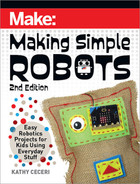
of the battery uncovered so the positive LED wires can touch the bare
metal.
• Bend the positive LED wires down until they’re almost touching the
positive side of the battery. This is your on-off switch (or pressure
sensor). The circuit closes when the positive wires touch the positive
side of the battery.
• Fold the frog back up. To test your circuit, press down on the back
of the frog. The eyes should light up. The positive LED wires should
touch the battery to close the circuit and light up the frog’s eyes
(Figure
Aa
)
. Let go, and the lights should turn off while the frog hops in
the air
(Figure
Bb
)
!
TROUBLESHOOTING TIPS
If it doesn’t work, look for things that can cause problems:
• The “switch”: If the lights don’t go on, try bending the top wires a little
closer. If they don’t go off, bend the wires a bit further away.
• The direction of the LEDs: Do both LEDs have their negative wires
below the battery and their positive wires above?
• The direction of the battery: If both LEDs are facing the same way, but
backwards, you can flip the battery over to make it work.
• Loose connections: Does metal touch metal on all connections? Is the
non-conductive clear tape in the way?
• Short circuits: Do negative and positive wires or conductive tape touch
each other, or touch the wrong side of the battery?
GO BEYOND
What other origami designs can you add circuits to? Try the origami luna
moth from Sandy Roberts’ book The Big Book of Maker Camp Projects. You
can find instructions on the Maker Camp site: makercamp.com/projects/
lightup-origami-butterfly.
Chapter 2: Robots That Get Around 41
Make_Simple_Robots_interior_FIN.indd 41Make_Simple_Robots_interior_FIN.indd 41 4/26/22 1:54 PM4/26/22 1:54 PM

Project: Make a Jittery Tensegrity Robot
BUILD A ROBOT WITH ENOUGH BOUNCE TO SHAKE ITS WAY
ACROSS THE TABLE.
Tensegrities are known for being squishable and bouncy — but that’s not
all they do. The word “tensegrity” — a combination of the words “tension”
and “integrity” — was coined by architect Buckminster Fuller, who also
invented the geodesic dome. But the structures do more than just bounce.
This tensegrity robot is based on prototypes developed by computer
scientist John Rieffel and his students at Union College in Schenectady,
New York. They “tune” their little tensegrity robots like guitar strings. Then
42
Making Simple Robots, 2nd Edition
Make_Simple_Robots_interior_FIN.indd 42Make_Simple_Robots_interior_FIN.indd 42 4/26/22 1:54 PM4/26/22 1:54 PM

they attach vibrating motors to
make them move in different
directions, depending on how fast
or slow the motor is shaking.
To understand how tensegrity
robots work, it helps to build
one yourself! The directions for
this drinking-straw-and-rubber-
band version came from a Make:
magazine article by Bre Pettis.
It uses small rubber bands to
hold the drinking straws in place
while you build. When you cut
the small rubber bands away, the structure pops open into its final form.
Then all you have to do is add a tiny vibrating motor and a battery to make
it move around. Try placing the electronics in different spots to see how the
movement changes. That’s the smart body at work!
WHAT TO EXPECT
• Time Needed: 1 hour
• Cost: $5–$10
• Difficulty: Easy to moderate
• Safety Issues: None
SKILLS USED
Making careful cuts
SUPPLIES
• 6 rubber bands, about 7 inches long
• 6 drinking straws about the same length as the rubber bands
(sturdy paper straws work well)
• 6 small thin rubber bands (such as pony tail or bracelet bands)
• Scissors
Steve Stangle
A tensegrity robot developed at Union College
which can be steered using vibration.
Chapter 2: Robots That Get Around 43
Make_Simple_Robots_interior_FIN.indd 43Make_Simple_Robots_interior_FIN.indd 43 4/26/22 1:54 PM4/26/22 1:54 PM

• Adhesive dots or double-sided tape
• Mini vibrating disk motor (must work with a 3V battery)
• Masking tape
• 3V coin battery (such as a CR2032)
• Conductive copper foil or nylon tape with conductive glue
• Small (3/4 inch) binder clip
• Optional:
• Wire stripper to expose more of the motor’s wire
• Hot glue gun to reinforce the ends of the straws
INSTRUCTIONS
1. To make the tensegrity:
• Cut slits on the ends of each straw. Make sure the slits line up on
both ends. The slits should be around 1/4 inch deep — just enough to
hold the rubber band in place
(Figure
A
)
.
• Line up two straws side by side. Hold them loosely in place at each
end with a small rubber band
(Figure
B
)
.
• Do the same to a second pair of straws. Then slide the second pair
between the first two straws to form an “X”
(Figure
C
).
44
Making Simple Robots, 2nd Edition
Make_Simple_Robots_interior_FIN.indd 44Make_Simple_Robots_interior_FIN.indd 44 4/26/22 1:54 PM4/26/22 1:54 PM

• Take the last two straws and wrap a small rubber band around one
end. Slide the other end in between the second pair of straws where
they cross the first pair. Wrap a small rubber band around the other
end
(Figure
D
)
.
2. To add the first big rubber bands:
• Hold the tensegrity so the ends of one pair of straws are facing you,
one on top of the other. Another pair of straws should be sticking
straight up
(Figure
E
)
. (The photos show a side view so you can see
the rubber band more clearly.)
• Line up the slits so they are both going side to side.
• Fit a big rubber band into the slit of the upper straw facing you
(Figure
F
)
.
A
C
E
B
D
F
Chapter 2: Robots That Get Around 45
Make_Simple_Robots_interior_FIN.indd 45Make_Simple_Robots_interior_FIN.indd 45 4/26/22 1:54 PM4/26/22 1:54 PM
..................Content has been hidden....................
You can't read the all page of ebook, please click here login for view all page.
